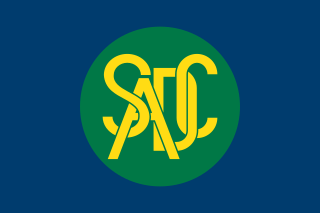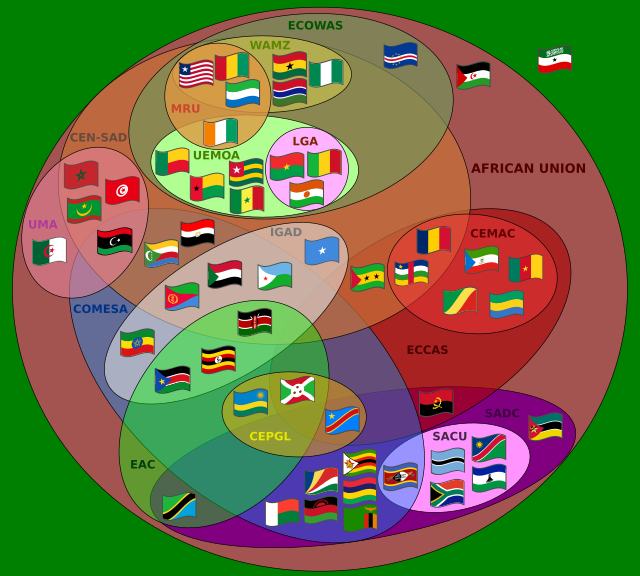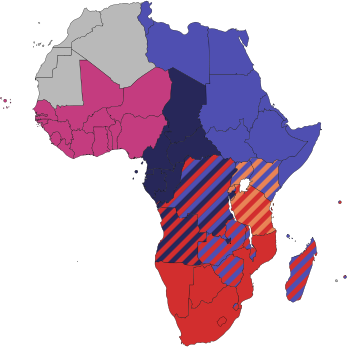
A customs union is generally defined as a type of trade bloc which is composed of a free trade area with a common external tariff.

An economic and monetary union (EMU) is a type of trade bloc that features a combination of a common market, customs union, and monetary union. Established via a trade pact, an EMU constitutes the sixth of seven stages in the process of economic integration. An EMU agreement usually combines a customs union with a common market. A typical EMU establishes free trade and a common external tariff throughout its jurisdiction. It is also designed to protect freedom in the movement of goods, services, and people. This arrangement is distinct from a monetary union, which does not usually involve a common market. As with the economic and monetary union established among the 27 member states of the European Union (EU), an EMU may affect different parts of its jurisdiction in different ways. Some areas are subject to separate customs regulations from other areas subject to the EMU. These various arrangements may be established in a formal agreement, or they may exist on a de facto basis. For example, not all EU member states use the Euro established by its currency union, and not all EU member states are part of the Schengen Area. Some EU members participate in both unions, and some in neither.

The Economic Community of West African States is a regional political and economic union of fifteen countries located in West Africa. Collectively, these countries comprise an area of 5,114,162 km2 (1,974,589 sq mi) and have an estimated population of over 424.34 million.
A trade bloc is a type of intergovernmental agreement, often part of a regional intergovernmental organization, where barriers to trade are reduced or eliminated among the participating states.

The Southern African Development Community (SADC) is an inter-governmental organization headquartered in Gaborone, Botswana.

The East African Community (EAC) is an intergovernmental organisation composed of seven countries in East Africa. The member states are the Democratic Republic of the Congo, the republics of Burundi, Kenya, Rwanda, South Sudan, and Uganda, as well as the United Republic of Tanzania. Salva Kiir Mayardit, the president of South Sudan, is the current EAC chairman. The organisation was founded in 1967, collapsed in 1977, and was revived on 7 July 2000.

The Southern African Customs Union (SACU) is a customs union among five countries of Southern Africa: Botswana, Eswatini, Lesotho, Namibia and South Africa. Its headquarters are in the Namibian capital, Windhoek. It was established in 1910.

The African Central Bank (ACB) is one of the original five financial institutions and specialized agencies of the African Union. Over time, it will take over responsibilities of the African Monetary Fund.

The Council of Arab Economic Unity (CAEU) was founded by Egypt, Iraq, Jordan, Kuwait, Libya, Mauritania, Palestine, Saudi Arabia, Sudan, Tunisia, Syria, United Arab Emirates and Yemen on May 30, 1964, following an agreement in 1957 by the Economic Council of the Arab League.

The Economic Community of Central African States is an Economic Community of the African Union for promotion of regional economic co-operation in Central Africa. It "aims to achieve collective autonomy, raise the standard of living of its populations and maintain economic stability through harmonious cooperation".

The African Monetary Union (AMU) is the proposed creation of an economic and monetary union for the countries of the African Union, administered by the African Central Bank. Such a union would call for the creation of a new unified currency, similar to the euro; the hypothetical currency is sometimes referred to as the afro or afriq. The single African currency is to be composed of currency units made up of regional union reserve bank currency units of which are made up country specific currencies.
The Regional Economic Communities (RECs) in Africa group together individual countries in subregions for the purposes of achieving greater economic integration. They are described as the "building blocks" of the African Union and are also central to the strategy for implementing the New Partnership for Africa's Development (NEPAD).

An economic union is a type of trade bloc which is composed of a common market with a customs union. The participant countries have both common policies on product regulation, freedom of movement of goods, services and the factors of production as well as a common external trade policy. When an economic union involves unifying currency, it becomes an economic and monetary union.

The African Free Trade Zone (AFTZ) is a free trade zone announced at the EAC-SADC-COMESA Summit on 22 October 2008 by the heads of Southern African Development Community (SADC), the Common Market for Eastern and Southern Africa (COMESA) and the East African Community (EAC). The African Free Trade Zone is also referred to as the African Free Trade Area in some official documents and press releases.
Integration is a political and economic agreement among countries that gives preference to member countries to the agreement. General integration can be achieved in three different approachable ways: through the World Trade Organization (WTO), bilateral integration, and regional integration. In bilateral integration, only two countries economically cooperate with one another, whereas in regional integration, several countries within the same geographic distance become joint to form organizations such as the European Union (EU) and the North American Free Trade Agreement (NAFTA). Indeed, factors of mobility like capital, technology and labour are indicating strategies for cross-national integration along with those mentioned above.
The Panel of the Wise (PoW) is a consultative body of the African Union, composed of five appointed members who each serve three year terms. Its mandate is to provide opinions to the Peace and Security Council on issues relevant to conflict prevention, management, and resolution. Representatives are chosen for the North, East, South, West, and Central regions of the continent.

A customs and monetary union is a type of trade bloc which is composed of a customs union and a currency union. The participant countries have both common external trade policy and share a single currency.

The Common Market for Eastern and Southern Africa (COMESA) is a regional economic community in Africa with twenty-one member states stretching from Tunisia to Eswatini. COMESA was formed in December 1994, replacing a Preferential Trade Area which had existed since 1981. Nine of the member states formed a free trade area in 2000, with Rwanda and Burundi joining the FTA in 2004, the Comoros and Libya in 2006, Seychelles in 2009 and Tunisia and Somalia in 2018.

The African Continental Free Trade Area (AfCFTA) is a free trade area encompassing most of Africa. It was established in 2018 by the African Continental Free Trade Agreement, which has 43 parties and another 11 signatories, making it the largest free-trade area by number of member states, after the World Trade Organization, and the largest in population and geographic size, spanning 1.3 billion people across the world's second largest continent.

















